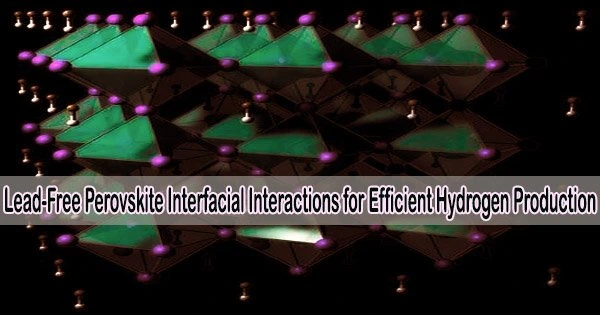A potential and environmentally friendly method for tackling the energy crisis and lowering emissions from fossil fuels is the conversion of solar energy into hydrogen energy. A research team from City University of Hong Kong (CityU) recently created a lead-free perovskite photocatalyst for solar energy to hydrogen conversion.
The interfacial dynamics of solid-solid (between halide perovskite molecules) and solid-liquid (between a halide perovskite and an electrolyte) interfaces during photoelectrochemical hydrogen generation were most importantly revealed. The most recent discoveries provide a path for future solar-powered hydrogen fuel production that is more effective.
Due to its abundance, high energy density, and environmental friendliness, hydrogen is regarded as a superior and more promising option to renewable energy sources. A viable alternative to photoelectrochemical water splitting is to split hydrohalic acid using photocatalysts powered by solar energy.
The majority of catalysts comprised of transition metal oxides or metal are unstable under acidic conditions, hence the long-term durability of photocatalysts is a significant concern.
“Lead-based hybrid perovskites are used to overcome this stability issue, but the high solubility in water and toxicity of lead limits their potential for widespread applications,” explained Dr. Sam Hsu Hsien-Yi, Assistant Professor in the School of Energy and Environment and the Department of Materials Science and Engineering at CityU. “Bismuth-based perovskites, in contrast, have been confirmed to provide a non-toxic, chemically stable alternative for solar-fuel applications, but the photocatalytic efficiency needs to be enhanced.”
An in-depth understanding of the interfacial interactions between halide perovskites and liquid electrolytes can build a scientific foundation for researchers in this field to further investigate the development of alternative and useful materials for solar-induced hydrogen production.
Dr. Sam Hsu Hsien-Yi
Motivated to design an efficient and stable photocatalyst, Dr. Hsu and his collaborators recently developed a bismuth-based halide perovskite with a structure of bandgap funneling for highly efficient charge-carrier transport.
It is a mixed-halide perovskite whose iodide ion distribution gradually decreases from the surface to the interior, generating a bandgap funnel structure that facilitates a photo-induced charge transfer from the interior to the surface for a successful photocatalytic redox process.
This newly designed perovskite has high solar energy conversion efficiency, exhibiting a hydrogen generation rate enhanced up to about 341 ± 61.7 µmol h−1 with a platinum co-catalyst under visible light irradiation. The findings were published half a year ago.
But Dr. Hsu’s team did not stop there. “We wanted to explore the dynamic interactions between the halide perovskite molecules and those at the interface between the photoelectrode and the electrolyte, which remained unknown,” said Dr. Hsu.
“Since photoelectrochemical hydrogen production involves a catalytic process, highly effective hydrogen generation can be achieved by intense light absorption using a semiconductor as a photocatalyst with a suitable energy band structure and efficient charge separation, facilitated by an external electrical field formed near the semiconductor-liquid interface.”
The team used temperature-dependent time-resolved photoluminescence to examine the energy transfer of electron-hole pairs between the perovskite molecules in order to learn about the kinetics of exciton transfer.
To demonstrate the efficiency of electron transport through the solid-liquid interfaces between a perovskite-based photoelectrode and the electrolyte, they also measured the diffusion coefficient and electron transfer rate constant of halide perovskite materials in the solution.
“We demonstrated how our newly designed photocatalyst can effectively achieve high-performance photoelectrochemical hydrogen generation as a result of efficient charge transfer,” said Dr. Hsu.
The team’s investigation also demonstrated that charge separation and transfer between the electrode and electrolyte interfaces were more effectively accomplished by bandgap funneling structured halide perovskites.
Faster photoelectrochemical activity on the photoelectrode’s surface is made possible by the enhanced charge separation, which can cause charge carriers to migrate onto the surface of halide perovskites deposited on the conductive glasses as the photoelectrode. As a result, under light irradiation, the efficient charge transfer inside the bandgap funnel-structured halide perovskites displayed increased photocurrent density.
“Uncovering the interfacial dynamics of these novel materials during the process of photoelectrochemical hydrogen generation is a crucial breakthrough,” explained Dr. Hsu. “An in-depth understanding of the interfacial interactions between halide perovskites and liquid electrolytes can build a scientific foundation for researchers in this field to further investigate the development of alternative and useful materials for solar-induced hydrogen production.”
The findings were published in the scientific journal Advanced Materials, titled “Unravelling the interfacial dynamics of band-gap funneling in bismuth-based halide perovskites.” The research study was selected to be featured on the inside back cover of Advanced Materials.
The corresponding author is Dr Hsu. The co-first authors are Dr. Tang Yunqi, who graduated from Dr. Sam Hsu’s lab last year, and Mr. Mak Chun-hong, a PhD student supervised by Dr. Hsu. Other collaborators include Professor Kai Ji-jung, Dr. Zhao Shijun and Mr. Zhang Jun, from the Department of Mechanical Engineering at CityU.
The Research Grants Council of Hong Kong, the Innovation and Technology Commission, the Shenzhen Science Technology and Innovation Commission, and CityU financially supported the research.
















